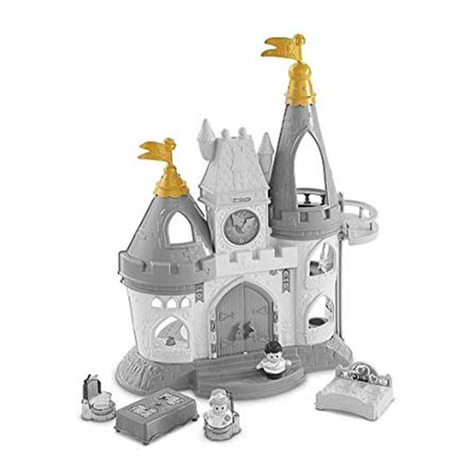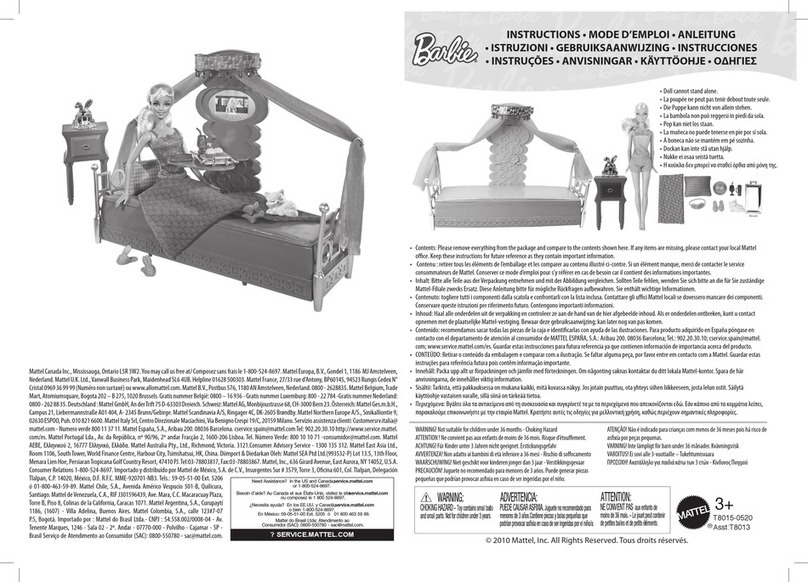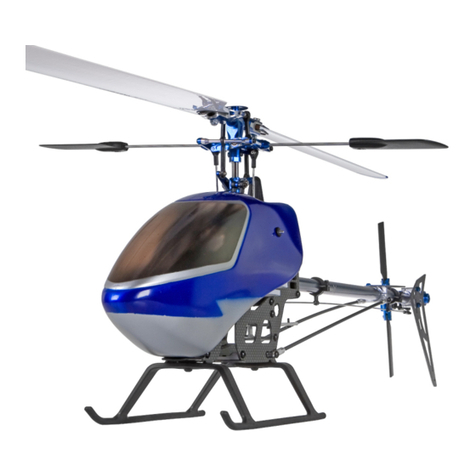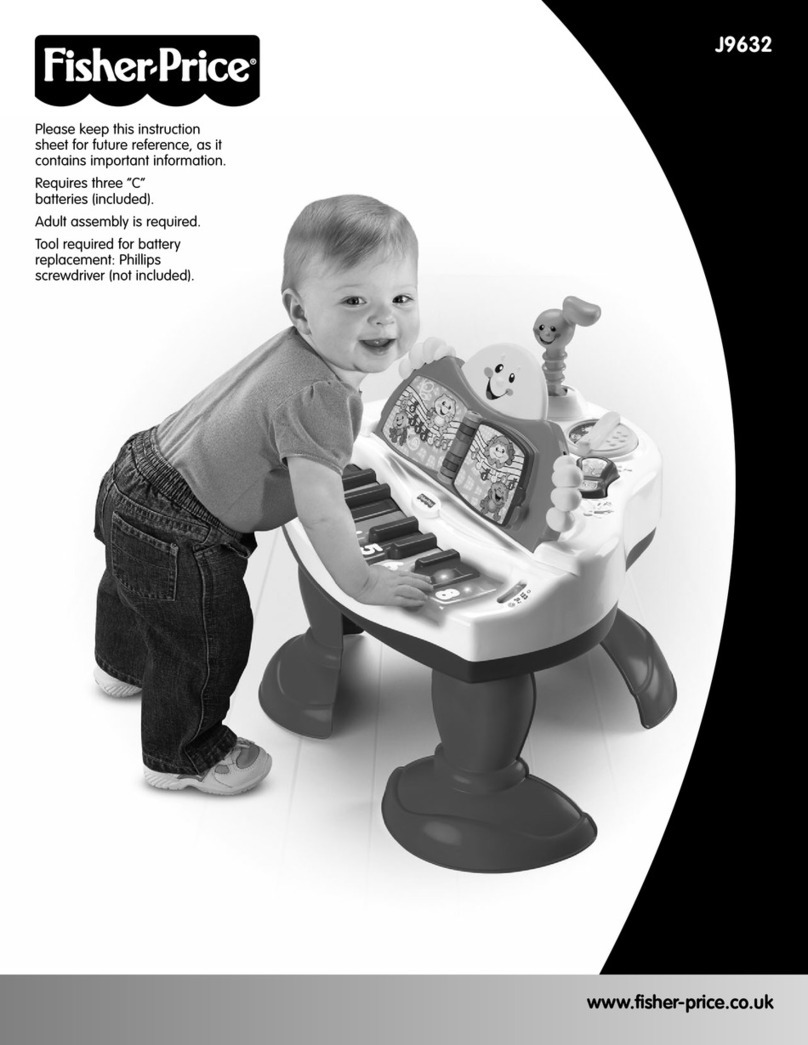Liqui Moly EC 145 User manual

EC 145 LIQUI MOLY
RTF 2.4 GHz LM001001
assisted by robbe Modellsport GmbH & Co. KG
Operating Instructions

2
Operating Instructions - EC145 LIQUI MOLY RTF 2.4 GHz No. LM001001
Contents Page
Explanation of specialist terms 2
Contents 2
Introduction / Pre-flight checklist 3
Safety Notes 4, 5
Set contents / Specification / Essential accessories 6
Description of transmitter functions / Inserting the dry cells 7
Charging the helicopter battery 8
Safety Notes regarding LiPo batteries 9
Control functions of the EC145 LIQUI MOLY RTF 10
Operating the model 11
Preparations for the first flight 11
Important notes 11
Flying 12
Conformity Declaration 13, 14, 15
Explanation of specialist
terms:
Motor speed ("Throttle"):
This controls the model's climb and descent.
Yaw:
The model's movement around the vertical
axis; the helicopter rotates to right or left.
Pitch axis:
The model's movement around the lateral
axis, Forward or reverse flight.

3
Introduction
Co-axial RC model helicopter which is particularly easy to fly.
The model of the EC145 enables you to make a start in the exciting world of radio-
controlled model helicopters, even if you have never previously flown such a model.
Its sleek looks, easily mastered flying characteristics and robust technology make our
EC145 LIQUI MOLY the ideal first step in indoor model helicopter flying.
Pre-flight checklist
Classification: 3-channel
co-axial rotor
Helicopter of scale
appearance
Qualification: Beginner
Flying conditions: Indoor
Flight time: 5 - 6 min.
Charge time: approx. 45 - 50 min.
(flight battery)
Radio control system: 3-channel -
2.4 GHz
(Values for flight and charge times are ap-
proximate, and may vary due to various in-
fluences)
Operating Instructions - EC145 LIQUI MOLY RTF 2.4 GHz No. LM001001

4
Be sure to read these Safety Notes before you assemble
your model. Always keep to the procedures and settings re-
commended in the instructions.
If you are operating a radio-controlled model aircraft, heli-
copter, car or boat for the first time, we recommend that you
enlist an experienced modeller to help you.
Safety Notes
Radio-controlled models are not toys in the usual sense of the term.
Young persons under fourteen years should only be allowed to ope-
rate them under the supervision of an adult.
Building and operating these models requires technical expertise,
manual skills, a careful attitude and safety-conscious behaviour.
Errors, negligence and omissions in building or flying these models
can result in serious personal injury and damage to property.
Since the manufacturer and vendor are not in a position to check
that your models are built and operated correctly, all we can do is
bring these hazards expressly to your attention. We deny all further
liability.
Helicopter rotors, and all moving parts generally,
constitute a constant injury hazard. It is essential to
avoid touching such parts.
Please bear in mind that motors and speed control-
lers may become hot when operating. It is important
to avoid touching these parts.
Do not stand close to the hazard area around rotating
parts when an electric motor is connected to the flight
battery.
You must also take care to keep all other objects away
from moving or rotating parts.
Ensure the equipment is protected from dust, dirt and moisture
contamination. Do not subject the system to excessive heat, cold
or vibration.
Use the recommended charger only, and charge the batteries
only for the prescribed period.
Check your equipment for damage at regular intervals.
Do not re-use any devices which have been damaged in a crash
or by water, even when they have dried out again.
Crash or water damage can result in concealed defects which
may lead to failure in subsequent use.
Use only those components and accessories which we specifi-
cally recommend.
Do not carry out modifications to the radio control system compo-
nents apart from those described in the instructions.
Operating Instructions - EC145 LIQUI MOLY RTF 2.4 GHz No. LM001001

5
Insurance
Ground-based models are usually covered by standard personal
third-party insurance policies. In order to fly model aircraft you
will need to extend the cover of your existing policy, or take out
specific insurance.
Check your insurance policy and take out new cover if ne-
cessary.
Liability exclusion:
robbe Modellsport and Liqui Moly are unable to ensure that you
observe the assembly and operating instructions, or the condi-
tions and methods used for installing, operating and maintaining
the model components.
For this reason we accept no liability for loss, damage or costs
which are due to the erroneous use and operation of our pro-
ducts, or are connected with such operation in any way.
Regardless of the legal argument employed, our obligation to
pay compensation is limited to the invoice value of those robbe
products directly involved in the event in which the damage oc-
curred, unless otherwise prescribed by law. This does not apply
if the company is deemed to have unlimited liability according to
statutory regulation due to deliberate or gross negligence.
Operating Instructions - EC145 LIQUI MOLY RTF 2.4 GHz No. LM001001
Operating the model
Caution - injury hazard:
Please keep your model helicopter - including small co-
axial and single-rotor models - a safe distance away from
yourself and others. Never fly over spectators, other pilots
or yourself. Always fly manoeuvres facing away from other
pilots and spectators. Please note that model helicopters
generally, and aerobatic types in particular, are subject
to enormous flight loads, and that interference cannot be
ruled out even when you are using the best possible radio
control system components. Operating these models re-
quires a highly responsible attitude and all possible safety
precautions for pilot and spectators.
•Neveryoverspectatorsorotherpilots,andmaintainasafe
distance from them at all times.
•Neverendangerpeopleoranimals.
•Neveryclosetohigh-tensionoverheadcablesorresidential
areas.
•Donotoperateyourmodelinthevicinityofcanallocksoropen
waterways.
•Do not operate your model from public roads, motorways,
paths and squares etc.; use authorised model flying sites only.
•Neveroperatethemodelinstormyweather.

Specification:
Main rotor diameter: approx. 180 mm
Tail rotor diameter: approx. 40 mm
Length: approx. 200 mm
Height: approx. 105 mm
Weight: approx. 40 g
RC functions:
Pitch-axis, yaw, climb / descent
Essential accessories:
6 x alkali-manganese dry cell
AA-size, 1.5 V
CAUTION!
Radio-controlled model aircraft are not
toys! A high level of technical expertise
and modelling experience are required to
complete, fly and maintain this model aero-
plane. Assembling and handling the model
and its technical equipment carelessly and
inaccurately can result in serious personal
injury and property damage.
6
Set contents:
•Co-axialmodelhelicopter,completelyassembledandsetup,readytoy
•Paintedandassembledinjection-mouldedplasticfuselagewithblackglazing
•InternalLiPobatteryinthefuselage
•FlightbatterychargefunctionviaUSBlead
•2.4GHzthree-channeltransmitter
•4xreplacementrotorblades
•1xreplacementtailrotorblade
•2xcontrolpushrods
•Operatinginstructions
Operating Instructions - EC145 LIQUI MOLY RTF 2.4 GHz No. LM001001

7
Description of transmitter functions
This transmitter sends the control signals to the helicopter using the 2.4 GHz frequency
band. Up to 75 different 2.4 GHz models can be in the air simultaneously without any
interference occurring between them.
Inserting the dry cells
Use a cross-point screwdriver to undo the
screw which retains the transmitter battery
compartment. Place six AA-size dry cells in
the compartment. Insert the cells the right
way round: the correct polarity is engraved
in each battery well. Finally close the batte-
ry compartment again and fit the retaining
screw; don't over-tighten the screw.
The red monitor LED indicates the state
of charge of the dry cells in the trans-
mitter. It should glow constantly while
you are flying; if it starts flashing, you
must land immediately and replace the
dry cells.
Motor speed control
(climb and descent)
Monitor LED
Transmitter battery
Trim wheel
Vertical axis
Yaw and pitch-axis control
(left / right = vertical axis)
(forward / back = lateral axis)
Main switch
On / Off
Operating Instructions - EC145 LIQUI MOLY RTF 2.4 GHz No. LM001001
Charge monitor LED
Light button
On / Off Demo button

Fig. A
Fig. B
8
Charging the flight battery
It is absolutely essential to give the flight battery a full charge before flying the co-axial
model helicopter for the first time. There are two possible methods of recharging the
pack:
a) Charging using the USB lead (Fig. A):
The ON/OFF* slide-switch (S) must be set to "OFF" (Fig. A).
Connect the USB plug to the USB socket of a computer, or a USB plug-type charger.
The red monitor LED in the USB plug now lights up. Locate the charge plug on the USB
lead, and connect it to the charge socket on the underside of the helicopter. During the
charge process the red monitor LED in the USB plug remains off.
Continue charging the helicopter's flight battery until the monitor LED on the USB plug
lights up again.
b) Charging using the transmitter lead (Fig. B):
The ON/OFF* slide-switch (S) must be set to "OFF" (Fig. A).
Open the cover for the transmitter's internal charge lead on the right-hand side of the
transmitter. Connect the charge plug to the helicopter. Switch the transmitter on to start
the charge process. During the charge process the green LED on the transmitter glows
constantly; it goes out when the flight pack is fully charged. The charge lead can now
be disconnected from the EC145, and the transmitter can be switched off. Stow the
charge lead in the charge well again. The battery in the helicopter is now charged up,
and the model is ready to fly.
The charge process takes about forty minutes regardless of the charge method em-
ployed.
*ON = on; OFF = off
S
Operating Instructions - EC145 LIQUI MOLY RTF 2.4 GHz No. LM001001

9
LIABILITY EXCLUSION
Since robbe Modellsport and Liqui Moly are not in a position to monitor the handling of these batteries, we expressly deny all liability
and guarantee claims where the batteries have been incorrectly charged, discharged or handled.
Safety Notes regarding LiPo batteries:
•Donotplacethebatteryinwateroranyotherliquid.
•Neverheatorincineratethepack,orplaceitinamicrowaveoven.
•Avoidshort-circuits,andneverchargethebatterywithreversedpolarity
•Donotsubjectthebatterytopressureorshockloads,andneverdistortorthrowthepack
•Neversolderdirectlytothebattery
•Donotmodifyoropenthebattery
•Batteriesmustonlybechargedwithasuitablecharger;neverconnectthebatterydirectlytoamainspowersupply.
•Neverchargeordischargeabatteryinbrightsunlight,orclosetoaheateroropenre.
•Donotusethebatteryinareassubjecttohighlevelsofstaticelectricity.
•Anyoftheseerrorscanresultindamagetothebattery,explosionorre.
•Keepthebatteryoutofthereachofchildren
•Ifelectrolyteshouldescape,donotexposeittore,asthematerialishighlyinammableandmayignite.
•Donotallowuidelectrolytetocomeintocontactwitheyes.Ifthisshouldhappen,ushwithcopiousamountsofwaterand
contact a doctor without delay.
•Theuidelectrolytecanalsoberemovedfromclothingandotherobjectsbyrinsingwithcopiousamountsofwater.
Operating Instructions - EC145 LIQUI MOLY RTF 2.4 GHz No. LM001001

10
Climb and descent Forward and reverse Rotate left and right
Control functions of the EC145 LIQUI MOLY RTF
Operating Instructions - EC145 LIQUI MOLY RTF 2.4 GHz No. LM001001
Trim
left / right

Operating the PSU
It is important to keep to the following se-
quence when switching the receiver (heli-
copter) and transmitter on and off:
Always switch the receiver (helicopter)*
on first, and only then the transmitter.
Note that the throttle stick on the trans-
mitter must be at the 'fully back' position!
The binding procedure between model and
transmitter is complete when the white mo-
nitor LED on the helicopter and the red mo-
nitor LED on the transmitter cease flashing,
and glow constantly.
After flying the model, always switch the
receiver (helicopter) off first, and only then
the transmitter. If you do not observe this
sequence, the transmitter and receiver (he-
licopter) may not bind.
*The helicopter's On/Off slide-switch is lo-
cated behind the charge socket (see page
8 of the instructions, Fig. A).
Please switch off after every flight,
otherwise the internal battery may be-
come deep-discharged.
11
Preparations for the first flight
Ideally the first flight should take place in a large indoor space devoid of obstructions.
The helicopter is not designed to be flown in the open air. If you wish to do this,
wait for a day with totally flat calm conditions.
Charge the flight battery before flying.
Important Notes
Take-off: raise the rotor speed slowly and steadily until the model hovers at a height of
about one metre. It is difficult to control the model when it is very low to the ground due
to the turbulence generated by the rotor.
Landing: slowly and steadily reduce the throttle setting until the helicopter descends
and touches down. Never reduce the throttle setting abruptly.
Caution: stopping (obstructing) the rotor blades when they are turning can cause
serious damage to the mechanical system, and may even result in a fire. Imme-
diately move the throttle stick to Idle if this should happen.
Note regarding the flight battery: as soon as you notice a reduction in motor power,
land immediately and disconnect the battery. Never continue flying until the battery is
flat, as this causes a deep-discharge condition which results in permanent damage.
Allow the battery to cool down before recharging it.
Ensure at all times that the tail rotor is free to rotate, and does
not foul the fuselage fairing.
Replacing the rotor blades: if a rotor blade is damaged, replace it immediately. When
fitting the new rotor blade, tighten the retaining screw just to the point where the blade
still swivels smoothly.
Operating Instructions - EC145 LIQUI MOLY RTF 2.4 GHz No. LM001001

12
Operating Instructions - EC145 LIQUI MOLY RTF 2.4 GHz No. LM001001
Fig. A
Fig. B Fig. C
Flying
1. Switch the helicopter and transmitter on (see paragraph "Ope-
rating the model" on page 11).
2. Place the helicopter on a horizontal surface in front of you,
with the tail pointing towards you.
3. Slowly and steadily move the throttle stick forward until the he-
licopter lifts off and hovers in front of you at a height of about
one metre. If it swings to left or right, rotate the trim wheel (Fig.
A) to correct the movement until the helicopter hovers smooth-
ly in front of you.
If you move the pitch-axis stick forward, the helicopter flies
forward. Pull it back towards you, and the helicopter flies back-
wards.
Moving the yaw control to the left causes the helicopter to turn
to the left. Move the yaw control to the right, and the helicopter
turns to the right.
4. You can switch the LED in the helicopter on and off in flight by
pressing the Light button (Fig. B).
5. If you press the Demo button (Fig. C) while the model is ho-
vering, the helicopter automatically flies a few metres forward,
then flies back again. After this it stops before turning to left
and right.
The monitor LED on the helicopter flashes during this "demo
flight". When the "demo flight" is over, the monitor LED lights
up constantly again.
You can terminate the "demo flight" at any time by pressing the
Demo button (Fig. C) again.
You can still control the helicopter's height with the throttle
stick.
Ensure that there is adequate space when carrying out a
"demo flight"!

13
Operating Instructions - EC145 LIQUI MOLY RTF 2.4 GHz No. LM001001
Manufacturer / responsible individual robbe Modellsport GmbH & Co. KG, Metzloser Strasse 38
D - 36355 Grebenhain
declares that the product JY912G LM001001 EC145 Liqui Moly RTF 2.4 GHz
Type (system confirguation with statement of modules where applicable):
Terminal telecommunications (TC) apparatus Radio system
Application Model radio control system
Device class 1
fulfils the fundamental requirements of § 3 and the remaining relevant requirements of FTEG (Article 3 of the R&TTE) when
correctly used.
Health and safety in accordance with § 3 (1) 1. (Article 3 (1) a))
Harmonised norms employed EN 60950-1 :2006+A1:2010+A12 :2011
EN 62479 :2010
EN 50581 :2012
Fulfilment of the fundamental requirements
by other means
(standards / specification employed)
Protective requirements relating to electro-magnetic compliance (§ 3 (1) 2, Article 3 (1) b)
Harmonised norms employed EN 301 489-1 V 1.9.2
EN 301 489-3 V 1.6.1
Fulfilment of the fundamental requirements
by other means
(standards / specification employed)
Conformity Declaration in accordance with the law regarding radio apparatus and telecommunications equipment
(FTEG) and Directive 1999/5/EG (R&TTE) and Directive 2011/65/EU (RoHS2 – directive)

14
Operating Instructions - EC145 LIQUI MOLY RTF 2.4 GHz No. LM001001
Measures for the efficient use of the radio frequency spectrum
Aerial interface for radio equipment in accordance with § 3 (2) (Article 3 (2))
Harmonised norms employed EN 300 440-2 V1.4.1
Fulfilment of the fundamental requirements
by other means
(description of standards / interface employed)
Address robbe Modellsport GmbH & Co. KG, Metzloser Strasse 38
D - 36355 Grebenhain
Telephone, fax, e-mail: Phone : +49-6644-870
Fax: +49-6644-7412
e-Mail: office@robbe.com
Grebenhain, 06.06.2013 Eberhard Dörr
Location, date Managing Director
Name and signature

Conformity Declaration in accordance with Directive RL 2004/108/EG (electro-magnetic compliance)
and Directive 2011/65/EU (RoHS2 – directive)
Manufacturer / responsible individual robbe Modellsport GmbH & Co. KG, Metzloser Strasse 38
D - 36355 Grebenhain
hereby declares that the product JY912G LM001001 EC145 Liqui Moly RTF 2.4 GHz
satisfies the following norms: EN 301 489-1 V 1.9.2
EN 50581 :2012
Address robbe Modellsport GmbH & Co. KG, Metzloser Strasse 38
D - 36355 Grebenhain
Telephone, fax, e-mail: Phone: +49-6644-870
Fax: +49-6644-7412
e-Mail: office@robbe.com
Grebenhain, 06.06.2013 Eberhard Dörr
Location, date Managing Director
Name and signature
15
Operating Instructions - EC145 LIQUI MOLY RTF 2.4 GHz No. LM001001

robbe Modellsport GmbH & Co.KG
Metzloserstraße 38 · D-36355 Grebenhain
Commercial register: Gießen Regional Court HRA 2722
Partner with personal liability:
robbe Modellsport Beteiligungs GmbH Gießen / HRB 5793
Managing Director: Philip Janssen
Errors and technical modifications reserved. - Copyright robbe Modellsport 2014
Duplication and copying of the text, in whole or in part, is only permitted with the prior written approval of robbe-Modellsport GmbH & Co. KG
16
Operating Instructions - EC145 LIQUI MOLY RTF 2.4 GHz No. LM001001
This symbol means that you should dispose of electrical and electronic equipment separately from the household waste when it reaches
the end of its useful life. Take your unwanted equipment to your local council collection point or recycling centre. This requirement applies to
member countries of the European Union as well as other non-European countries with a separate waste collection system.
Disposal of batteries
Batteries must not be discarded as domestic refuse. To protect the environment, always discharge exhausted or de These include retail sales
outlets for batteries, and communal toxic waste disposal centres. Cover any bare wires with insulating tape in order to avoid short-circuits.
This product can be operated in all EU countries.
LIQUI MOLY GMBH
Jerg-Wieland-Straße 4 D-89081 Ulm
www.liqui-moly.de
Ulm regional court HRB 1383 Managing Director: Ernst Prost
Table of contents
Popular Toy manuals by other brands
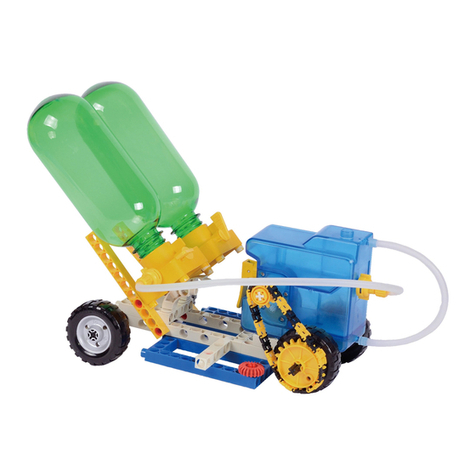
Thames & Kosmos
Thames & Kosmos Air Plus Water Power Plus Experiment manual
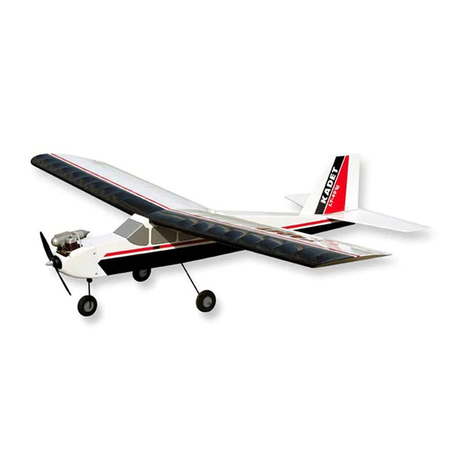
SIG
SIG KADET LT-40 EG Assembly manual
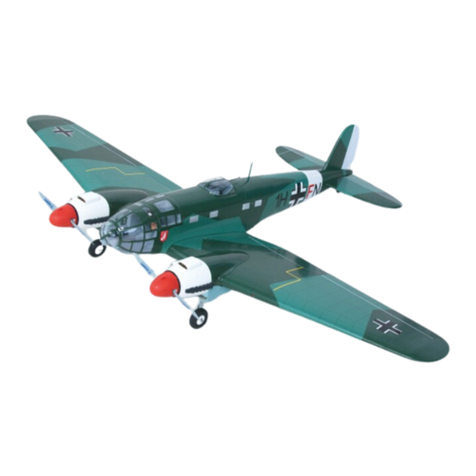
GRAUPNER
GRAUPNER Heinkel He 111 instructions
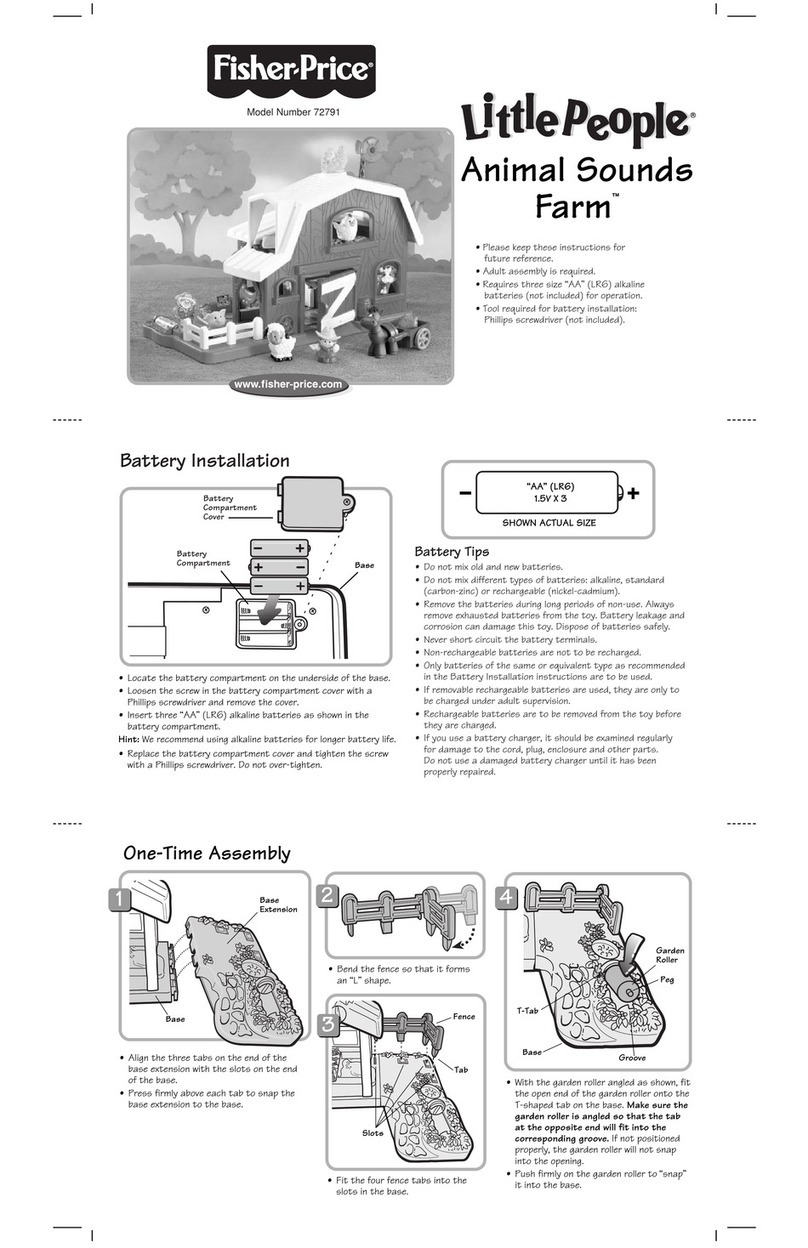
Fisher-Price
Fisher-Price Little People Animal Sounds Farm Series manual

Smoby
Smoby B+D BRICOLO TRUCK quick start guide

PARKZONE
PARKZONE Vapor BNF instruction manual






